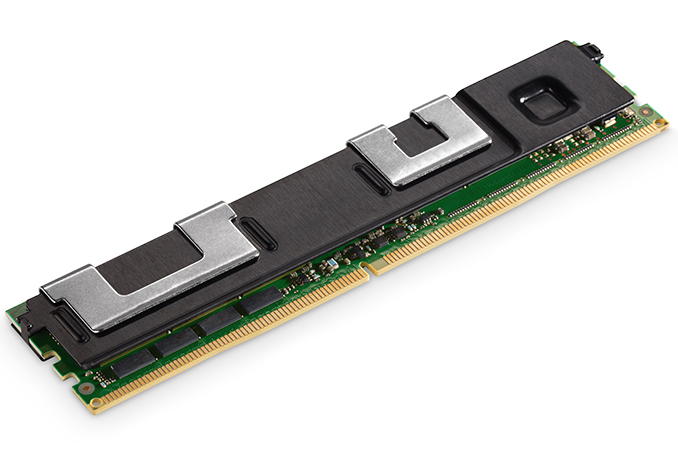Pricing of Intel’s Optane DC Persistent Memory Modules Leaks: From $6.57 Per GB
by Anton Shilov on April 5, 2019 3:15 PM EST- Posted in
- Memory
- Storage
- Intel
- Optane
- Optane DIMMs
- Optane DCPMM

At least two retailers from the US on Friday have started to take pre-orders on Intel’s Optane DC Persistent Memory modules and therefore had to reveal their prices. Today they only offered 128 GB and 256 GB modules, possibly indicating that the range-topping 512 GB Optane is set to ship a bit later.
The main purpose of Intel’s Optane DC Persistent Memory modules is to bring higher memory capacities closer to the CPU at a fraction of DRAM cost. Even with recent drops of DDR4 prices, high-capacity RDIMMs and LRDIMMs (i.e., 128 GB or 256 GB) cost thousands of US Dollars. Meanwhile, Intel’s 3D XPoint memory used for Optane-branded products is cheaper to make than DRAM, but offers a high performance and a strong endurance, so in many cases using Optane DC Persistent Memory instead of DDR4 makes sense for memory-intensive applications.
Without any surprises, Intel’s Optane DC modules are priced in accordance with their market positioning: well above regular SSDs, but well below DDR4 RDIMMs/LRDIMMs of the same capacity. Depending on the retailer, the Optane DC 128 GB costs $842 - $893, whereas the Intel Optane DC 256 GB is priced at $2668 - $2850. Keep in mind that these are not official MSRPs of Intel (which will likely keep its RCPs confidential as they will depend on multiple factors), but prices at which certain retailers may sell them.
| Pre-Order Prices of Optane DC Persistent Memory Modules | ||||
| CompSource.com | ShopBLT.com | |||
| Optane DC Persistent Memory 128 GB | $893 $6.97 per GB |
$842 $6.57 per GB |
||
| Optane DC Persistent Memory 256 GB | $2,850 $11.13 per GB |
$2,668 $10.42 per GB |
||
| Optane DC Persistent Memory 512 GB | ? | ? | ||
Unfortunately, neither of the retailers that started to take pre-orders on Intel’s Optane DC Persistent Memory revealed their ETA. Intel’s official position is that actual systems that use the modules will be available in June, so it looks like the chip giant is about to start shipments of its Optane DIMMs to interested parties.
Related Reading:
- Intel’s Enterprise Extravaganza 2019: Launching Cascade Lake, Optane DCPMM, Agilex FPGAs, 100G Ethernet, and Xeon D-1600
- Intel Launches Optane DIMMs Up To 512GB: Apache Pass Is Here!
Source: Compsource.com (1, 2), ShopBLT.com (1, 2) (via Momomo_US/Twitter)










59 Comments
View All Comments
Toadster - Monday, April 8, 2019 - link
that's ~$5.43/GBFunBunny2 - Saturday, April 6, 2019 - link
I think I hear, in the distance, the death rattles of client-side coders of RDBMS. "We prefer to do transactions in our clients". the InnterTubes client machine reduced to VT-220 status. my heart goes flutter flutter.mrvco - Saturday, April 6, 2019 - link
At those prices, Apple must be involved somehow.Valantar - Monday, April 8, 2019 - link
I don't think you're quite familiar with enterprise-grade hardware prices ...Supercell99 - Sunday, April 7, 2019 - link
Whats the use case for this?Xajel - Sunday, April 7, 2019 - link
While the idea of having 128GB of semiRAM is awesome. Today's consumer grade NVMe are very competitive to Optane, they offer higher bandwidth for lower cost. The only things consumer Optane NVMe provides is better IO & better performance consistency. Which in real consumer world doesn't do that much and the consumer will mostly prefer higher capacity for the same price of regular NVMe drives.What could those PM DIMM's do for consumers then ?
Maybe prosumers, mainly those who do content creations, other computing hobbies which can benefit from this, But it's still hard too to justify, they can always have a larger standard NVMe drive and use it as a cache drive. A lot of applications already support this kind of thing while almost nothing yet support the PM DIMM.
FunBunny2 - Sunday, April 7, 2019 - link
the most important use for persistent "RAM" is the RDBMS. one gets rid of all those sync points between caches, DRAM, SSD, HDD and so on. transactions are only written once, to one place. yes, the engines will need to know when they're writing to such machines, and I suspect the OSs as well. but, man, what a difference there'll be.all industrial RDBMS use memory buffers, often under their engine's control rather than the OS, in addition to all those other stops along the way to persistence. just getting rid of those makes a huge difference, as well.
vaibhav24 - Wednesday, April 10, 2019 - link
#MemoryModule Market Analysis - http://bit.ly/2D5NHwpThe Memory Module industry concentration is not high; there are more than one twenty manufacturers in the world, and high-end products mainly from U.S. and Western European.
Global giant manufactures mainly distributed in China and Taiwan. The manufacturers in China have a long history and unshakable status in this field. Manufacturers such as Kingston (Shanghai) and Ramaxel (Suzhou) have relative higher level of product’s quality. As to Taiwan, ADATA has become as Asia leader.
Damatrino - Friday, January 28, 2022 - link
These sound like hot nice modules but on Intel W3 site it seems they only plug into Intel server MOBO's so for common use it maybe a few years yet still useless some moves it down into common use. HP's Persistent modules for 128 gb were selling $1,253.75 CA for HP Modules at NewEgg but the silly link wouldn't take to any place were it give anymore info. or how to purchase it. Much good that was! I'll keep hunt and searching and one day maybe I'll find out more about this stuff than general info. and talk.